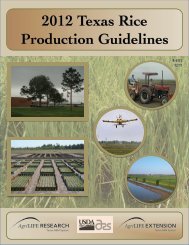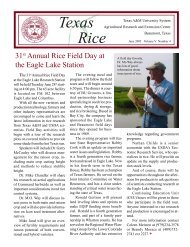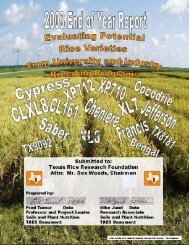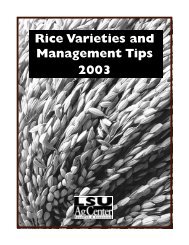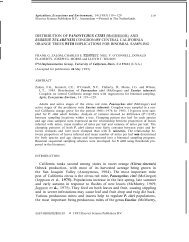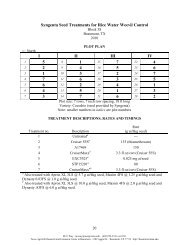2007 - Texas A&M AgriLIFE Research Center at Beaumont - Texas ...
2007 - Texas A&M AgriLIFE Research Center at Beaumont - Texas ...
2007 - Texas A&M AgriLIFE Research Center at Beaumont - Texas ...
Create successful ePaper yourself
Turn your PDF publications into a flip-book with our unique Google optimized e-Paper software.
Table 19. Insecticides for rice w<strong>at</strong>er weevil control (continued).<br />
zeta-cypermethrin<br />
• Mustang MAX kills adults, which prevents egg laying. Thus, timing of Mustang MAX is critical for control. <strong>Texas</strong> d<strong>at</strong>a show<br />
applic<strong>at</strong>ions l<strong>at</strong>er than 10 days after permanent flood are ineffective.<br />
• Zeta-cypermethrin does not interact with propanil.<br />
• Do not release tre<strong>at</strong>ed w<strong>at</strong>er within 1 week of applic<strong>at</strong>ion.<br />
• Do not apply more than 0.1 lb a.i. per acre per season.<br />
• Do not use tre<strong>at</strong>ed rice fields for aquaculture of edible fish and crustaceans.<br />
• Do not apply within 14 days of harvest.<br />
• Do not enter tre<strong>at</strong>ed field for 12 hours after applic<strong>at</strong>ion.<br />
For additional inform<strong>at</strong>ion on the above products, read the labels or contact the <strong>Texas</strong> Agricultural Experiment St<strong>at</strong>ion <strong>at</strong> 409.752.2741.<br />
Chinch bug<br />
(Blissus leucopterus leucopterus)<br />
Identific<strong>at</strong>ion, biology and damage<br />
Chinch bugs overwinter as adults. They are black, about<br />
1<br />
⁄8- to 1 ⁄6-inch long and elong<strong>at</strong>e about three times longer<br />
than wide. When viewed from above, the adult appears to<br />
have a white “x” on its back. Females are larger than males.<br />
These insects have piercing-sucking mouthparts, which<br />
they insert into the food-conducting tissues of plants and<br />
withdraw fluids. If you turn the insect on its back, you can<br />
see the long, strawlike mouthparts usually held between its<br />
legs.<br />
Adults overwinter and can move into fields after the rice<br />
emerges. Females lay elong<strong>at</strong>e orange eggs about 1 ⁄16-inch<br />
long on rice stems, between leaf she<strong>at</strong>hs and stems, and in<br />
the soil. In the spring, eggs typically h<strong>at</strong>ch in about 12 days.<br />
First-instar nymphs are orange and about 1 ⁄16-inch long.<br />
Five instars (stages) are completed in about 40 days with<br />
each successive instar being larger and darker. The last<br />
instar is black, has conspicuous wing pads and is almost as<br />
large as the adult.<br />
Newly emerging rice is most susceptible to damage and<br />
de<strong>at</strong>h. Symptoms of chinch bug damage include striping,<br />
stippling and yellowing of leaves. Severely affected seedlings<br />
turn brown and die.<br />
Inspect the rice often for chinch bugs from emergence to<br />
about 3 weeks l<strong>at</strong>er. Look for adults on foliage and behind<br />
leaf she<strong>at</strong>hs; then inspect the stem; and finally probe the<br />
soil around the plant. Also, bend the seedling from side to<br />
side and closely inspect the gap between soil and stem for<br />
chinch bugs.<br />
Recent <strong>Texas</strong> d<strong>at</strong>a show th<strong>at</strong> as few as an average of<br />
one chinch bug per two seedlings can cause significant<br />
mortality in rice, as well as reduction in height and delay in<br />
m<strong>at</strong>urity of the surviving plants. If popul<strong>at</strong>ions on seedling<br />
rice approach an average of one adult per two plants, quick<br />
control is suggested.<br />
Table 20. Insecticides for chinch bug control.<br />
Active ingredient/product<br />
carbaryl<br />
Sevin ® 50W<br />
Sevin ® 80WSP<br />
Sevin ® 80S<br />
Sevin ® XLR<br />
Sevin ® 4F<br />
Active ingredient<br />
1.0–1.5 lb<br />
1.0–1.5 lb<br />
1.0–1.5 lb<br />
1.0–1.5 lb<br />
1.0–1.5 lb<br />
R<strong>at</strong>e per acre<br />
Product<br />
2–3 lb<br />
1 1 ⁄4 – 1 7 ⁄8 lb<br />
1 1 ⁄4 – 1 7 ⁄8 lb<br />
1–1 1 ⁄2 qt<br />
1–1 1 ⁄2 qt<br />
Timing of applic<strong>at</strong>ions<br />
Apply when adult popul<strong>at</strong>ions approach an average of one per<br />
two seedlings.<br />
gamma-cyhalothrin<br />
Prolex 0.0125–0.02 lb 1.28–2.05 fl oz Apply when adult popul<strong>at</strong>ions approach an average of one per<br />
two seedlings.<br />
lambda-cyhalothrin<br />
Kar<strong>at</strong>e ® Z 0.025–0.04 lb 1.6–2.56 fl oz Apply when adult popul<strong>at</strong>ions approach an average of one per<br />
two seedlings.<br />
zeta-cypermethrin<br />
Mustang MAX 0.0165–0.025 lb 2.64–4.0 fl oz Apply when adult popul<strong>at</strong>ions approach an average of one per<br />
two seedlings.<br />
(continued on next page)<br />
–––––––––––––––––––––––––––––––––––––––––––––––––––––––––––––––––––––––––––––––––––– 37



